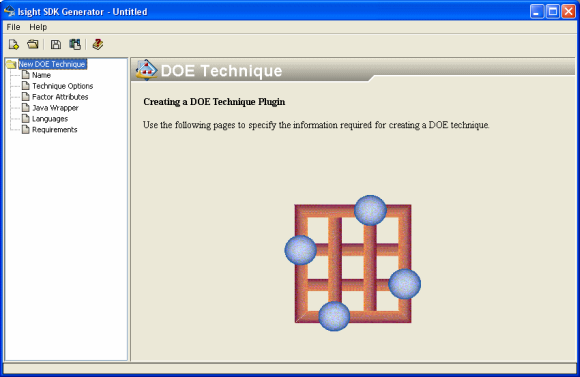Do one of the following to launch the SDK Generator:
- From the Design Gateway
Tools menu, select SDK Generator.
- Launch the SDK Generator from the command line
as follows:
-
Windows: Execute the sdkGenerator.exe file located in the <Isight_install_directory>\<operating_system>\code\bin
directory.
-
Linux: Execute the sdkGenerator file located in the <Isight_install_directory>/<operating_system>/code/bin
directory.
The Isight SDK Generator
dialog box appears in the default configuration for generating components.
From the File menu, click New
and select Plug-in.
The Select a Plug-in Category dialog box appears.
Select the type of plug-in you want to create.
A description of the plug-in appears on the right side of the dialog
box.
Click OK.
You are returned to the Isight SDK Generator
dialog box. Depending on the type of plug-in you are creating, you will
see a specific set of items listed on the left. The following example
shows the SDK Generator configuration for developing a DOE Technique
plug-in.

Click each of the items on the left side of the Isight
SDK Generator; and define the required information, following the instructions
provided on the right side of the SDK Generator.
Use the appropriate template provided by SIMULIA for your plug-in
type to create the Java wrapper.
Each plug-in type requires different methods to be implemented specific
to the functionality that the plug-in must provide. Detailed information
is provided for the following plug-ins:
- Approximation techniques
- Calculation
- Grid
- Optimization techniques
For all other types of plug-ins, only the templates and javadocs are
provided. For more information, contact your SIMULIA support representative.
Compile your Java wrapper.
Assuming that you have the JDK installed and it is on your system
path, run the following from a command prompt to compile your code:
javac -classpath <isight_install_dir>/<os_dir>/docs/java/SMAFIPsdk.jar
MyWrapper.java
where MyWrapper.java is replaced with the name of your
Java wrapper.
Once you have defined all the necessary settings, or at any time during
the plug-in creation process, select Save from the File menu to save
the jar file for your plug-in.
You can also click Save  on the SDK Generator toolbar.
on the SDK Generator toolbar.
If desired, click  to publish the plug-in to the Isight
library.
to publish the plug-in to the Isight
library.